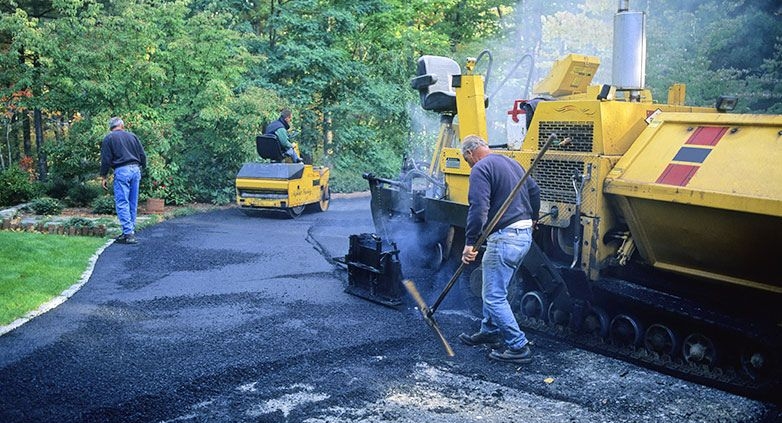New Asphalt Driveway Issues – 10 Common Problems Finally Solved
When it comes to the longevity and aesthetics of your property, having a well-maintained driveway is crucial. However, even with the best intentions, issues can arise. One common concern that homeowners may encounter is related to a new asphalt driveway issue. In this article, we will delve into common problems associated with newly paved driveways and provide insights on how to address them.
If you’ve recently had an asphalt driveway installed and are facing problems, you might be dealing with a new asphalt driveway issue. These issues could range from poor workmanship to unforeseen complications arising during the curing process. Recognizing the particular issue marks the initial phase in discovering a resolution. In the sections below, we will discuss potential challenges associated with new asphalt driveways and offer guidance on how to mitigate and resolve these issues.
Explore crucial insights for homeowners dealing with new asphalt driveway issues. Delve into the root causes and effective solutions to address problems like cracks, uneven surfaces, and drainage issues. This article empowers you with essential knowledge to navigate these challenges, ensuring your asphalt driveway withstands the test of time. Dive into details now for a resilient driveway.
The 10 Most Common New Asphalt Driveway Issues

It’s important that you be able to recognize a potential problem with your new asphalt quickly. This fast awareness is key to ensuring the problem can be effectively resolved. Here are ten signs that your new driveway is in trouble and what you need to look out for.
After briefly explaining each of these 10 problems, we’ll dig into how they can be fixed. Just keep reading!
Issue #1: Water-Filled Depressions
Water pooling in low or sunken-in areas of your asphalt is almost always a bad sign. In the case of new asphalt driveways, these depressions in the pavement form a result of the asphalt not being fully compacted during the paving process.
It’s important to treat this issue with your asphalt early, as a lack of remediation can compromise the asphalt’s surface and weaken the integrity of your driveway overall.
Issue #2: Potholes
Similar to depressions, potholes indicate that your asphalt has been subjected to bad weather and possibly standing water during or shortly after the paving process.
Standing water and poor weather conditions can cause chunks of asphalt to dislodge from the pavement’s surface. The resulting potholes are not only an eyesore for your driveway, but they can also cause considerable harm to your vehicles and their tires.
Issue #3: Asphalt Upheaval
Upheaval in a section of pavement is caused when the soil beneath your asphalt expands. This expansion often occurs when either an increase in moisture fills the soil or water freezes into ice in the ground, expanding the ground as it does so.
The expansion of the ground pushes against the asphalt, which causes the subgrade to swell and move upward, thus causing the upheaval in your pavement.
Issue #4: Surface Breakdown (“Raveling”)
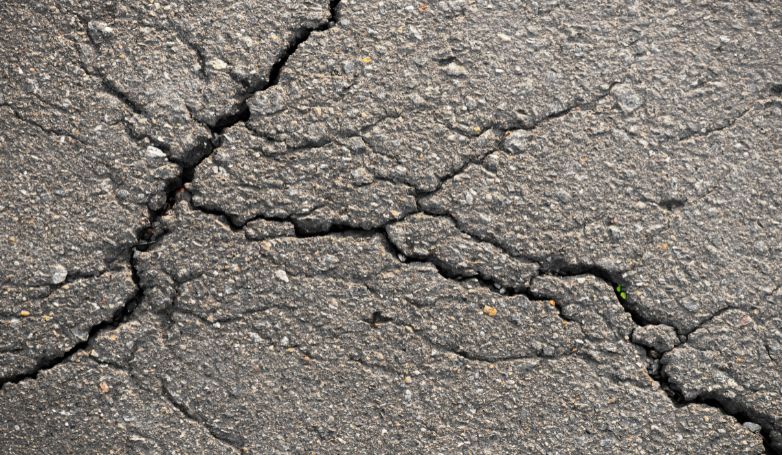
Raveling occurs when the particles of your asphalt’s surface begin to break down and crumble away. Like many of the other new asphalt driveway issues, we’ll cover here, standing water can be a contributor to this breakdown.
The chunky, uneven texture indicative of asphalt raveling is the result of left-behind debris and grit.
Issue #5: Longitudinal Cracking
As the name suggests, longitudinal cracks in your driveway are cracks that run lengthwise through your pavement, in the same direction in which the asphalt was applied (so, long ways down your driveway, not across from side-to-side).
Longitudinal cracking occurs when the asphalt shrinks, which can happen when temperatures drop significantly. It’s for this reason that many professional asphalt pavers prefer to lay new driveways in summer.
Issue #6: Edge Cracking
Edge cracks develop under the pressure of heavy traffic loads concentrated near the sides of your pavement. Therefore, edge cracking is indicated by cracks appearing in your asphalt along the very edges of your driveway.
While this is typically a more common occurrence on rural roads, you could see signs of edge cracking in your new driveway if you park a heavy vehicle near the border of the new pavement.
Read more: Brick Driveway Edging
Issue #7: Crescent Cracking
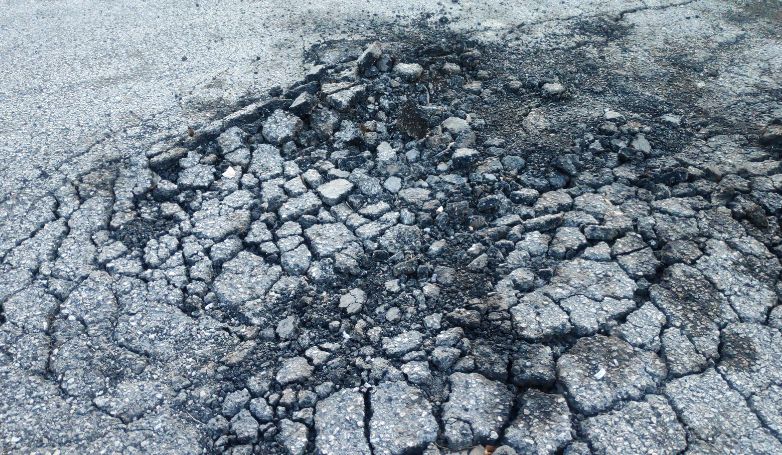
The occurrence of crescent-shaped cracking on freshly laid asphalt typically points to the use of subpar bonding agents beneath the surface. This specific problem, often referred to as “slippage” cracking, is characterized by distinctive wave-like patterns of cracks that bear a resemblance to puddles on the pavement’s surface.
Slippage cracking is a result of inadequate adhesion between the asphalt layers, particularly in instances where the bonding agents used lack the necessary quality. These crescent-shaped cracks are not only a cosmetic concern but can also signify structural weaknesses within the pavement. Understanding the underlying causes of slippage cracking is crucial for effective remediation.
Issue #8: Fatigue Cracking (“Alligator” Cracking)
So-called for the scale-shaped patterns created by their intersecting lines, “alligator” cracks are caused by a combination of asphalt issues. Most often, this kind of fatigue cracking occurs when a weak subgrade is overloaded with heavy traffic, highlighting potential issues in a new asphalt driveway. Therefore, alligator cracking is the compounded result of both too-heavy a load and poor sub-grade materials in the context of new asphalt driveway issues.
Issue #9: Block Cracking
Block cracking is cracking that occurs in large rectangular or square sections. The rectangular patterns created by these cracks often measure a foot or more across and can occur no matter how much or how little traffic the pavement is subjected to.
Block cracking is likely to occur in the event that an old or dried-out batch of asphalt was used in the paving process. Alternatively, it can also occur if the asphalt binder used in the pavement is unable to expand and contract with fluctuations in outdoor temperatures.
Issue #10: Reflective Cracking
Last, but not least of your asphalt problems to be concerned about, reflective cracks are cracks mirrored in your new asphalt from the underlying pavement you likely had resurfaced.
This means that the cracks existing in the old surface of your driveway have affected the new asphalt, reflecting the same cracks in the new pavement. While many people think that they can simply pave over old asphalt issues to fix them, reflective cracking shows us that this isn’t always the case.
Each of these ten warning signs could mean bad news for your pavement. To ensure your new asphalt driveway issues are addressed correctly, be sure to speak to a professional if you notice one or more of these problems with your asphalt.
7 Solutions to Fix Common New Asphalt Driveway Issues
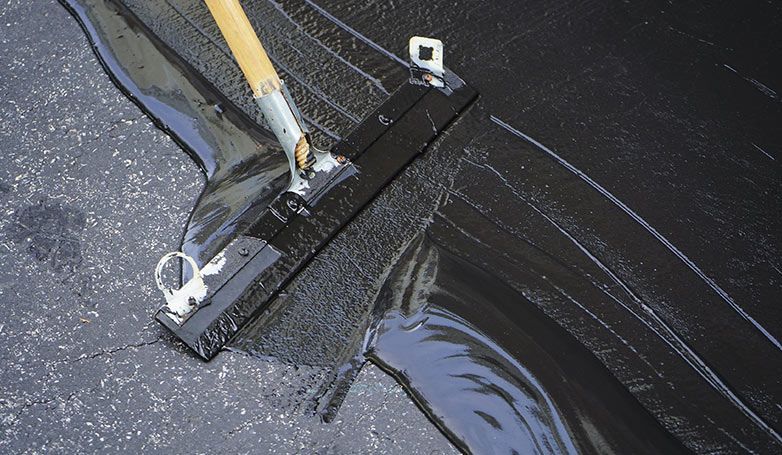
Though we’ve listed off nearly a dozen issues here that can affect a new asphalt driveway, the remedies to many of these problems come back to about half-a-dozen key solutions.
In general, there are seven ways to fix most new asphalt driveway issues:
1. Full-depth asphalt patch
This comprehensive remedy involves a meticulous examination of the asphalt’s structural integrity, allowing for targeted repairs throughout its various layers. By addressing underlying issues at every level, the full-depth asphalt patch not only rejuvenates the surface but also reinforces the overall resilience of the pavement. This method is particularly effective for extensive repairs, ensuring that the asphalt’s core is strengthened to withstand the test of time, making it a prudent investment in the longevity of your pavement.
2. Surface patch
While ideal for minor repairs, the surface patch solution’s versatility extends to serving as a quick aesthetic fix for small imperfections. Its user-friendly application makes it an accessible choice for homeowners seeking immediate results without compromising the integrity of their driveway. This solution is perfect for those looking to enhance curb appeal swiftly, providing a seamless and visually pleasing resolution to minor surface irregularities.
3. Pavement removal
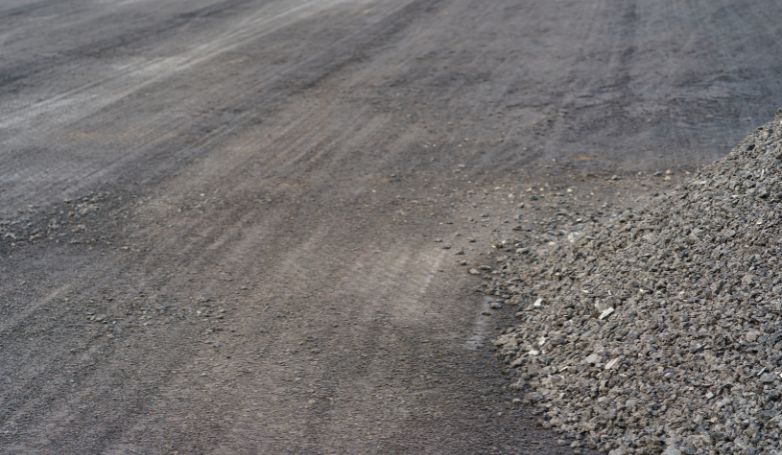
Viewed as a pivotal precursor to full-scale repair, pavement removal is a strategic process that unveils the extent of underlying issues. Disposing of faulty pavement becomes a transformative step, clearing the canvas for a more intricate and lasting solution to effectively remedy asphalt-related challenges. This method ensures a clean slate for subsequent repairs, minimizing the risk of lingering issues and allowing for a comprehensive overhaul that guarantees a revitalized and enduring asphalt surface.
4. Sub-grade replacement
Beyond surface renewal, sub-grade replacement digs deep to correct issues at their roots. This method not only ensures a renewed and stable foundation but also facilitates a seamless integration of the repaired sub-grade with the subsequent application of a full-depth asphalt patch. This comprehensive approach is essential for addressing new asphalt driveway issues effectively, ensuring a harmonious and enduring asphalt surface. The precision involved in sub-grade replacement guarantees a uniform and robust foundation, laying the groundwork for flawlessly restoring the asphalt structure and mitigating any potential new asphalt driveway issues.
5. Base-strengthening
Tailored for experienced paving professionals, base-strengthening demands a nuanced understanding of materials and thicknesses. This solution involves a precise calibration of the asphalt’s foundational elements, providing a fortified base that is essential for the longevity and structural integrity of the pavement. With an expert touch, base-strengthening transforms your asphalt into a resilient surface capable of withstanding heavy traffic and environmental challenges, ensuring a durable and steadfast foundation for years to come.
6. Sealcoating
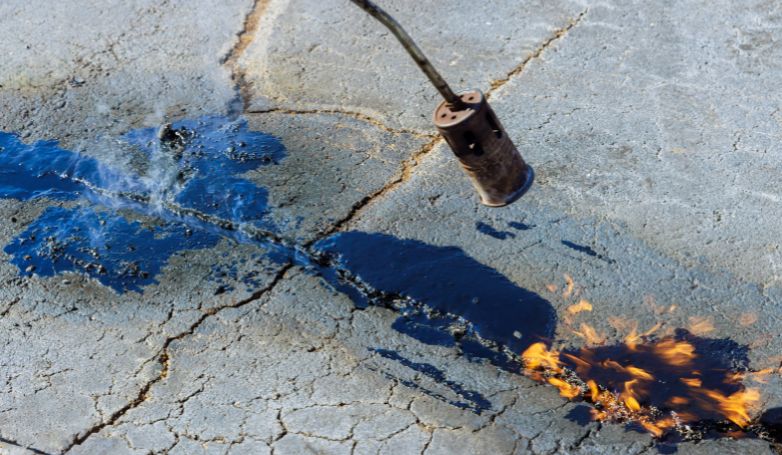
Operating as a dual-purpose solution, sealcoating acts as both a shield against future damage and a quick fix for existing cracks. While suitable for minor issues, its protective layer serves as a preventative measure, prolonging the life of your driveway and offering a temporary solution as more extensive repairs are organized. This cost-effective measure not only enhances the aesthetic appeal of your asphalt but also serves as a proactive defense, preserving the integrity of your driveway against the harsh elements.
7. Drainage installation
Going beyond asphalt repair, drainage installation is a proactive measure to mitigate water-related issues. By addressing poor water drainage, this solution prevents standing water, a common culprit for asphalt deterioration, ensuring the longevity of your driveway and minimizing the risk of future problems. Installing proper drainage systems is an investment in the health of your asphalt, safeguarding it from potential water-related damage and preserving the pristine condition of your driveway for years to come.
7 Steps to Care For a Newly Paved Driveway

While some driveway issues can only be avoided through the use of a careful and professional asphalt contractor, other issues like general wear and tear over time can be prevented through regular care and maintenance.
To make sure your new driveway lasts as long as possible and ensure that you get your money’s worth out of it, there are a few general recommendations that new driveway customers should adhere to.
To care for a new asphalt driveway, follow these best practices:
1. Fix all potential issues with your asphalt as soon as possible
Taking swift action to address any potential problems with your asphalt is paramount to preventing more intricate issues down the line. Although it may be tempting to delay fixing that crack, these seemingly minor concerns can escalate, leading to more complicated and costly complications if not resolved promptly. Proactive maintenance is particularly crucial for preventing and managing new asphalt driveway issues. This approach not only preserves the aesthetics of your asphalt but also safeguards its structural integrity for long-term durability, ensuring a resilient and reliable surface.
2. Be mindful of driving roughly on hot days
As temperatures rise, the top layer of your asphalt becomes malleable, making it susceptible to damage from heavy loads and tire tracks. Driving carefully on hot days is essential to prevent unsightly impressions and depressions on your driveway. By being mindful of the impact of high temperatures on your asphalt, you contribute to its longevity and maintain its smooth, flawless appearance.
3. Have a knowledgeable professional inspect your asphalt regularly
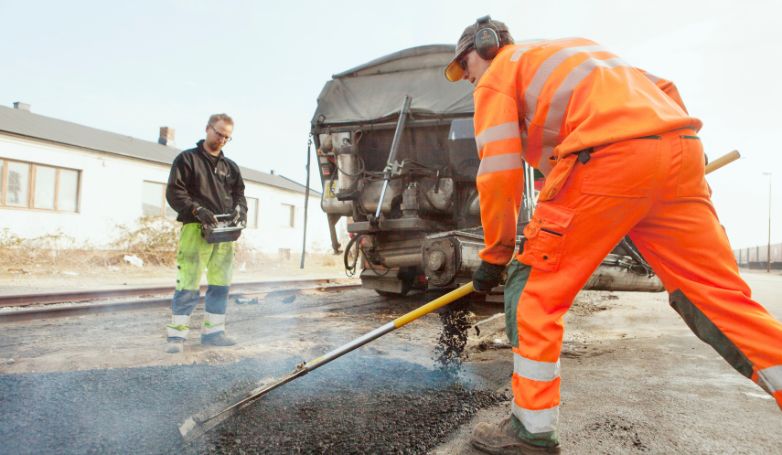
Bi-annual inspections by knowledgeable professionals serve as a proactive measure to save both time and money in the long term. These experts possess the expertise to identify potential pavement issues before they manifest into larger problems. Regular inspections provide a comprehensive overview of your asphalt’s condition, enabling timely interventions and ensuring the sustained health of your driveway.
4. Avoid turning your steering wheel while your vehicle is at rest
Preventing power steering divots in your newly laid asphalt involves a simple yet crucial practice: refrain from turning your steering wheel when your vehicle is at rest. By limiting steering maneuvers to reversing or driving, you minimize the risk of unsightly impressions on your asphalt, preserving its pristine appearance and structural integrity.
5. Have a proper drainage system in place
Standing water poses a significant threat to asphalt longevity, making a proper drainage system essential. Redirecting water away from your driveway is a proactive measure to prevent deterioration over time. Investing in effective drainage safeguards your asphalt, ensuring it remains resilient and resistant to the detrimental effects of stagnant water.
6. Restrict heavy-volume and high-volume traffic

Heavy and frequent traffic loads contribute to stress-related cracking in asphalt. If you own large vehicles like RVs, campers, or trailers, consider parking them elsewhere to alleviate the strain on your driveway. Similarly, relocating trash bins to the curb rather than having collection trucks drive onto your driveway minimizes the impact of heavy loads, preserving the structural integrity of your asphalt.
7. Clean up any accidental oil or fuel spills immediately
While oil or gas spills may not cause immediate structural damage to your asphalt, allowing them to linger can result in unsightly stains. Swiftly cleaning up any accidental spills is crucial to maintaining the visual appeal of your driveway and preventing long-term discoloration. Proactive cleanup ensures that your asphalt remains both structurally sound and aesthetically pleasing.
Prioritizing meticulous care for your driveway may demand attention to detail, but this proactive approach safeguards your new asphalt, extending its lifespan and preventing new asphalt driveway issues in the long run. This commitment to maintenance sets the stage for a durable and visually appealing driveway, ensuring that potential problems are addressed promptly for a resilient and long-lasting surface.
How Long Should Asphalt Driveways Last?
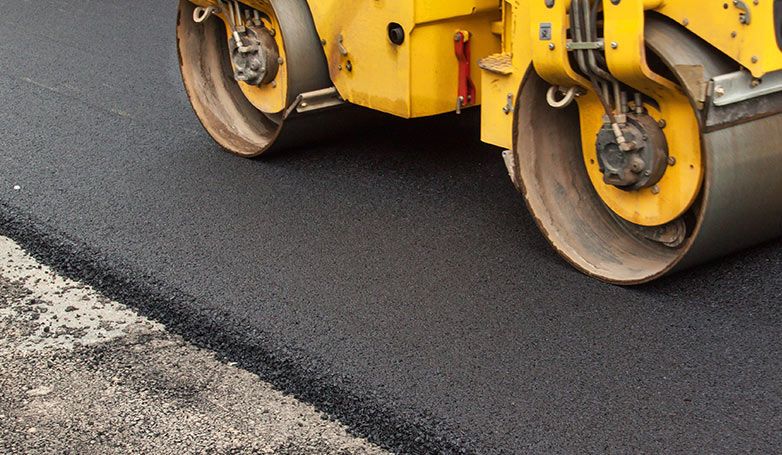
If you follow the asphalt care tips mentioned in this article, it’s conceivable that your new driveway could last as long as 25-30 years. However, even the most conscientious of driveway owners can only do so much if their asphalt wasn’t laid properly from the start.
To make sure that your investment in your property is worth it, make sure you choose a paving contractor with a good reputation and expert-level industry knowledge.
If you notice any of the new asphalt driveway issues discussed above in your own pavement, the key to extending the life of your driveway will be to address those issues as soon as possible.
Can I Redo My Own Driveway?
In short, you could, but we wouldn’t recommend it.
As the plethora of new asphalt driveway issues covered here reveals, there are many things that can go awry when paving a driveway. Everything from the time of year to sub-grade materials used, to the quality of bonding agents impacts the end product of your asphalt.
While many do-it-yourself hopefuls are tempted to tackle such an undertaking themselves, this is one home improvement project that’s best left to the professionals. At best, it would be wise to do no more than handle the installment of a surface patch while you wait for an appointment with a proper driveway expert.
However, if you want to learn more about the ins and outs of asphalt and new driveways, you can find this information and more among our other expert advice articles.
Conclusion
In conclusion, a newly paved driveway can encounter various issues, from water-filled depressions to reflective cracking, including potential new asphalt driveway issues. Recognizing these signs early is crucial, and solutions range from intensive full-depth asphalt patches to less complicated surface fixes. Proactive care, such as prompt issue resolution, careful driving on hot days, and regular professional inspections, contributes to the longevity of your asphalt, addressing and preventing new asphalt driveway issues. Engaging in preventive measures like proper drainage, restricting heavy traffic, and swift cleanup of spills further preserves the pavement’s integrity. A well-maintained driveway, coupled with a reputable paving contractor, can extend its lifespan to 25-30 years. While the appeal of DIY projects exists, the intricacies of asphalt paving underscore the importance of professional expertise for lasting and visually appealing results in managing new asphalt driveway issues.

